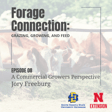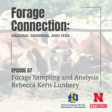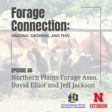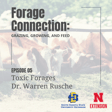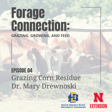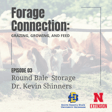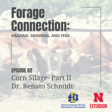Become a Creator today!Start creating today - Share your story with the world!
Start for free
00:00:00
00:00:01

Corn Silage: Dr. Renato Schmidt - Part 1
We talk all things corn silage with Dr. Renato Schmidt from Lallemand Animal Nutrition.
Transcript
Introduction to The Forage Connection
00:00:04
Speaker
It's The Forage Connection, grazing, growing, and feed with your hosts, Ben. And Sarah.
Guest Introduction: Dr. Hanato Schmidt
00:00:10
Speaker
Today we're talking all things corn silage. Joining us is Dr. Hanato Schmidt, the forage production specialist with Lalaman Animal Nutrition. Welcome Dr. Schmidt.
Dr. Schmidt's Background
00:00:22
Speaker
Can you tell us a little bit about yourself? Yes. Well, first of all, I'd like to thank you for the invitation. It's always a pleasure to talk about, you know, silage.
00:00:33
Speaker
And I'm originally from Brazil. I grew up on a dairy that became a beef operation. Then I came to US to pursue my PhD with Dr. Liming Kang at the University of Delaware. So I did a lot of research with silage additive, silage management. And then I started working with Lalamon, which was a pretty nice transition because I still use a lot of what I research on my daily task, on my daily routine.
00:01:02
Speaker
So I've been in the company for the past 15 years. I do tech support basically in all North America. So whatever people need some help, I'm traveling and helping onsite or even just by emails or a webinar or something. Sounds like you definitely have some experience. So it'll be exciting to see what you have to share with us today.
Understanding Corn Silage Fermentation
00:01:28
Speaker
So we're today going to be talking kind of all things corn silage and just trying to go over a kind of thousand foot view of the process as we get into corn silage harvest season here in the Midwest. And I think maybe the first thing to start off with our conversation today, Dr. Schmidt, would just be, you know, going over what
00:01:49
Speaker
Are we talking about when we're talking about silage and especially kind of what that fermentation process that we're trying to achieve with silage harvest and production, what that looks like? Yes, Ben. As you mentioned, it's a fermentation process. So as a definition, and I really like this definition, the silage is an aerobic process for preservation of forest crops of adequate moisture content. And if you think of like a chair, you have all these far legs and moisture content is one of them.
00:02:19
Speaker
So you need that proper moisture range depending on the forage crop. Also, the fermentation is a lactic acid fermentation. So there's a conversion of these simple sugars. I did it to lactic acid. That's a very strong acid that will pickle everything. And we were talking about anaerobic fermentation. So the presence of air in the forage mass will be the primary factor that negatively affects this process.
00:02:51
Speaker
And the final one, it's the right microbes that will do this job. So we talk about the moisture, about the sugars, that's the fuel for the fermentation, the lack of oxygen or no oxygen, and the right microbes.
Key Factors in Silage Fermentation
00:03:08
Speaker
So we know that the plant comes from the field colonized by microbes and the insulin is a naturally occurring process.
00:03:15
Speaker
But we want to make sure that it will be very efficient. So that's one of the reasons why to use a microbe inoculant is just to direct that fermentation. And I think the in-siling process is, I would say it's more like a run to make it the most efficient as possible to retain the majority of the original nutrients and dry matter. But there are always going to be some losses just because we have all that process
00:03:44
Speaker
of fermentation, the harvest, the feed out, and all those things. But in the end of the day, we're just trying to make it really efficient. Maybe a little bit of a follow up to that. There's lots of different ways when we're talking forages that we can go about harvesting when animal feed stuffs. What makes, I guess, silage maybe a...
00:04:04
Speaker
a better option or why are we choosing silage instead of trying to take something for hay or, you know, in this case, we're talking corn, you know, a lot of times we just take that for its grain. What makes silage an option that we want to be looking at from a harvest standpoint?
Corn Silage Benefits
00:04:20
Speaker
Yeah, I think in terms of corn silage, I would say mostly is the consistency of the food, of the feed.
00:04:28
Speaker
And especially for high producing dairy animals, that will be really important to have that consistency in terms of the nutrients. And with the corn silage, there is that good blend of fiber digestibility, as well as on the energy side with the starch. So it's really, and it's a plant that it's
00:04:52
Speaker
very insilable, let's say it's really easy to exile. So you have all these different characteristics, it's just easy to pickle, you have that consistency, and there's a pretty nice overall tonnage or yield, and the fiber and the starch size that I just mentioned.
00:05:10
Speaker
Corn's pretty popular in our area, so that helps too. We've got the market for it. And on a dry year especially, there's really some opportunity there to salvage grain crops if it's an issue that does make ensiling quite enticing when you don't have much of an ear or struggling to make a good grain crop.
Optimizing Silage Yield
00:05:33
Speaker
Speaking of corn in the field, what do you think, Dr. Schmidt, how do we get the most out of what we have in the field when we're talking about silage? I would say it's important to monitor the crops, walk the fields and see what it looks like, assess any sort of challenge during the growing season. As you mentioned, there is a drought.
00:06:03
Speaker
So what should expect for instance, there is a drought normally, it's going to lead to a lower yield, lower accumulation of starch, but on the other hand, the plant has a lot more of this soluble sugars. So this will start impacting the fermentation because you have all that, you know, amount of sugars that will make it more prone to spoilage. So then the fermentation has to be directly in a particular way.
00:06:31
Speaker
So I guess it's just to be aware of what the situation is. Also drought, you could have some issues with the nitrate accumulation. So it's more like, okay, this is my starting point. And sometimes we cannot deal or control or sometimes we cannot control weather, but you can always try to do the best with the management. So it's, I would say it's just know what you have, know what the challenges are.
00:06:59
Speaker
And what's the best that can be done from that particular situation? Absolutely. Even when we have a great year, environmentally speaking, we still have that catch of making sure we harvest at the right time. So what are your tips for getting great harvest timing for corn silage or any silage?
Harvest Timing for Ideal Silage
00:07:24
Speaker
Uh, for corn silage, uh, one like rough estimate and just like a starting point, I think would be when the, uh, with the Tesla emergency and the difference between the Tesla emergency and the time that you should be harvesting for silage. It's about 35, 45 days. So again, you're walking the fields, you see what it looks like. And then you have already like, okay, I should expect maybe six weeks or so.
00:07:55
Speaker
Some people still like to go with the milk line. And I don't think it's really like a reliable indicator. It can be a good guide in the beginning. But there are so many different corn hybrids and so many different traits. So sometimes you're following that milk line, but it's still very immature in terms of moisture. So I think you can rely on this about a quarter of the milk line. And that would relate to maybe
00:08:25
Speaker
30% on the dry matter. But ideally, I would say 32 to 38% dry matter would be the range for corn silage. That's the best compromise in terms of yield, the starch accumulation, starch adjustability, as well as on the fiber characteristics. So not only fiber adjustability, but also the physical characteristics of the plant for a good packing.
00:08:55
Speaker
So if someone wants to use a more accurate method than milk line, how do you suggest going about testing that silage to know what moisture you're at?
Testing Silage Moisture
00:09:06
Speaker
There are several different methodologies. And you're the farm you want to do as fast as possible. So there are some handheld, NIR devices that they are available. So they, of course, you need the device and you have to pay a subscription.
00:09:24
Speaker
to be able to see the readings and the database and everything. You can also have, you can see this online, like several different methodologies. You can use a microwave, you could use air fryer or food dehydrator. And also there's the equipment, the coaster. But the coaster, on my experience, it
00:09:50
Speaker
kind of overestimate the dry matter. So it's normally a couple of points drier than it is. And I had to learn that on a hard way when I was in grad school that we'd go to the field and chop some plants and run the coaster. And it was like, oh, it's ready to go. And when we were filling up the back silos, we could see some of the juice just run. It was like, oh my goodness, that's not what we were planning.
00:10:18
Speaker
So I would say there are all these different methodologies and I would just recommend to stick to one of them because there will be some difference between them. But as long as you have one methodology and you have that sort of consistency. And I would say it's the same thing as grabbing a sample and submitting to a lab A or submitting to a lab B. So there are like different calibrations on the equipment
00:10:44
Speaker
Uh, the person that's running everything it's, it's different, has a different, uh, experience. So just your stick with one methodology would be the best. And you have all these different types of techniques that can be used.
00:10:58
Speaker
Definitely. And you mentioned the microwave. One thing I've learned about the microwave test is you do not do that in your house. It does not end well. Your family will not be happy. It smells. So do that in the shop. I might ask or throw in there, you know, I really appreciate that thought about
00:11:20
Speaker
figuring out and kind of sticking what works for you. We have producers that do the hand squeeze test and they've done it enough times. They know that roughly the feel and they get pretty darn close. They've harvested silage enough that they know
00:11:36
Speaker
what they're looking for from that standpoint.
Handling Moisture Variability
00:11:39
Speaker
But as we're looking, a lot of times, at least in our neck of the woods, we've got custom choppers that are coming in. A lot of the operations that put up silage aren't big enough to have their own chopper.
00:11:52
Speaker
And so they're kind of a little bit at the beck and call of whoever's able to make it in their time schedule. And so we're not always hitting that perfect window from a moisture standpoint. And maybe we're jumping a little bit ahead on the conversation here. But, you know, if we go into a field and we see that we're a little bit wetter than what we should be, you know, is there really anything that we can be doing? The choppers there, they're ready to go. They want to go.
00:12:20
Speaker
you know, what can we be doing when the moisture content's not exactly where it should be?
Consequences of Improper Harvesting
00:12:27
Speaker
Yeah, specifically on corn silage, when it's, you know, the maturity follows these, you know, the dry matter. So when we decided to harvest and it's too wet and too immature, then you have those issues with the excessive moisture and the seepage and all that liquid, you know, that it's
00:12:48
Speaker
It makes contamination, lost nutrients, odors, all those things. Also, so much moisture inside of that forage mass will lead to a more extensive fermentation. So what I mean is a dilution type of effect that the microbes need to produce more acid to pickle everything. And this might lead to a high acid load. I never heard of an actual like animals backing off from the bunk because of that.
00:13:18
Speaker
but also you're going to be losing a little on the energy potential of that corn silage because of the low starch accumulation. Now, if we talk to the customer harvester and, oh, can you come a little, a few days later, you know, you think of a 0.75% of dry down per day, but then when it comes back, it's getting a little too dry. So there is no actually added yield to start having some issues
00:13:48
Speaker
with the low digestibility of the starch just because the starch granules form like a matrix with the protein in the kernels. And also this might lead to issues with the poor packing because of all the oxygen that's trapped is harder to pack. Also high probability of molding or some fungi activity
00:14:14
Speaker
So they both have these minuses, if you will. So sometimes the folks think, oh, if I harvest really late, I'm still going to get more of that starch. But one, it's not going to be easy to break that kernel, because it's getting harder and harder, even with the kernel processing. And you tie those processing roles. There's so much you can get out of that stuff. And then the actual matrix that's formed and leads to a lower starch digestibility.
00:14:44
Speaker
It is a challenge. It is kind of an issue in the field when you're trying to manage and schedule everything accordingly with the producer and the custom chopper. But then it's one of those two things that will be an issue. Is there any opportunity, Dr. Schnitt, for wilting? Do you work with any growers that try to wilt their silage when it's too wet? Not in terms of corn silage.
00:15:13
Speaker
just other silages or legumes or grasses, cereal crops. So in, well, yeah, legumes and grasses. We recommend 35, 40% dry matter to ensile. And in terms of the maturity, it's always, you know, you try to mow before it hits that reproductive phase.
00:15:41
Speaker
So around, you know, a tenth of a bloom for alfalfa or late boot stage for the grasses. And also that 35 to 40 percent, it's a good window in terms of the fermentation. And then we start getting on different types of microbial activities that we want to suppress. For instance, Clostridia. So Clostridia really likes wet conditions. So that's one of the important reasons to wilt that material. And they're everywhere.
00:16:11
Speaker
I receive a lot of samples from the labs, sample results, and you see that high contents of ash normally, so that relates to soil contamination, and the soil particles harbor some of these Clostridium spores. So in this particular situation of those crops, when they say, oh, I would rather have a challenge when it's too wet or too dry, I heard this from Dr. Keith, late Dr. Keith Bolson, I would go with too dry. You can try to figure something out.
00:16:42
Speaker
reduce the chop length or work with some chemical additive during feed out is necessary. But if it's too wet and you end up with a Clostridial disaster, yeah, then there's not much what to do. Now, particularly on cereal crops, you can follow the same as a grass, which it is.
Starch and Feed Efficiency
00:17:01
Speaker
So you either harvest when it's really young in terms of maturity. So there is a lot, you know, the contents of crude protein is really high.
00:17:11
Speaker
there is a good amount of fiber that the justability of that fiber is pretty high too. So you can either choose that point that's kind of like a rocket fuel almost, but then some people also like to wait. And I see this a lot when I go to Western Canada that they do a lot of barley and they wait until like it's more mature just to get a little more on that starch because corn silage is not always an option for the folks up there.
00:17:41
Speaker
So speaking of starch, I guess that's one of the things when we're looking at different silage options that corn silage has going for it. Can you speak just a little bit about what that benefit is of having that starch profile from the kernel and why we're really trying to hit that sweet spot? Yes. The 32 to 38% dry matter is when you see most of that accumulation and it's, let's say, has like the most potential for digestibility.
00:18:10
Speaker
So there is some study that was done at the University of Florida and they harvest, I think it was 30, 35, 40, 45% dry matter. And you could see that the amount of tons per acre didn't change much, but then in the end you just start losing a little on the fiber justability, but also they started justability just because the kernel was, you know, as I mentioned too hard and you had all that matrix going on.
00:18:40
Speaker
It's almost like a cement around a starch granules. And it's almost like an analogy with lignin and the fiber digestibility. So this would, some factors that impact this starch availability. One, it's the type of hybrid. So one of the more like vitreous types of kernels, they will have a large stability. The moisture, so higher moisture on corn, especially high moisture corn. You see more of that fermentation going on.
00:19:10
Speaker
And the protein is called the prolamines, they start to break down and free those starch granules for digestion. So if it's a little more on the wet side, that will help with the starch digestibility, the type of hybrid and also a storage length. So the dairy people, they normally see this, you know, they call the false lump because that's when they change from that old silage that's been cooking for months and months and months.
00:19:40
Speaker
you want sometimes that they just brought in and it's been sometimes weeks or not even that in the silo. So if the producer can wait a couple of months at a list, that would make a pretty good difference. The ideal spot would be three to four months. Then you can see like this curve that
00:20:04
Speaker
It goes pretty fairly steep on the initial months. And after four or five months, it kind of slows down the curve. So the initial months would be more of an impact. And if they have like an inventory or they can do some different like piles aside, that would be very beneficial for just for this star just stability and the energy value of the corn silage.
00:20:30
Speaker
What's that starch bringing to the table? If we were comparing a small grain silage that's got a very low amount of actual starch in it, what's the benefit of that starch in the corn silage from the animal side? Yeah, with the corn silage, it's still a fairly easily digestible source of energy. It has a high energy potential, the starch. And when you see a corn silage plant almost
00:21:00
Speaker
almost a half its grain. There is a lot of energy. It's more like a 40, 45% I guess grains when you think of the whole plant. But this will just, you know, in these times that margins are tight and everything is becoming harder and harder. And people also are having these issues with the weather and short inventories and you have that feed that's not only easily to exile,
00:21:28
Speaker
But then you have all this energy potential that will lower your feed cost, your supplemental feed. So it's just like, why not to add this corn silage as much as possible in the diet? I guess to summarize that or to wrap my mind around that, if we're thinking about starch, basically we're cramming as much energy into a small package as we can.
00:21:52
Speaker
and we want to hit that perfectly so we can break that back up and get as much energy back out of it. And so we're trying to find that sweet spot where we have as much energy in there before we start to get to the point where you were talking earlier about that becoming undigestible and we're capturing energy that's just going to shoot out the back end of the cow eventually. Yes, that's right. We have
00:22:17
Speaker
It's kind of like an audit program, like a service that we offer. And we do a total profile on the silages, but then we also go through bands or check some fecal consistency. We send to the lab and check the fecal starch. And sometimes we see so much that just went through the animal, like you said. And at the end of the day, we're just trying to
00:22:46
Speaker
convert that to the animal to either make more milk or just convert more in terms of energy value.
Alternative Energy Sources in Silage
00:22:53
Speaker
And there are also some options depending on each operation on what they need. And you can go for the whole plant corn silage, but you can do like a high chop and leave some material in the field if you're just trying to just proportionally have more on that energy value.
00:23:15
Speaker
Also, there is, you know, some options such as it's an apple age or earlage that you start leaving more and more of that, you know, stover or that some people say trash on the field. And ultimately, the high moisture corn, that's just, you know, purely the grains. So with the corn plant, you have all these different alternatives depending on what else is available, you know, in your neck of the woods, if you have some particular byproducts.
00:23:42
Speaker
or if you have like more land to produce some other crops. So you still have all this flexibility. And even with the corn silage, you're still gonna have a pretty high energy crop.
Conclusion and Next Episode Teaser
00:23:56
Speaker
Our conversation with Dr. Schmidt covered more than we could jam into one episode. So you'll have to join us next time as we continue talking all things corn silage. Thank you for taking the time to listen today and for joining us on The Orange Connection.
